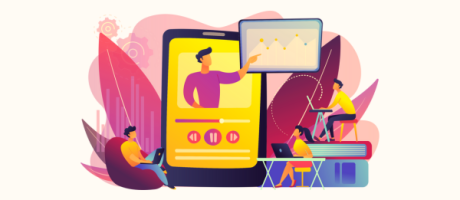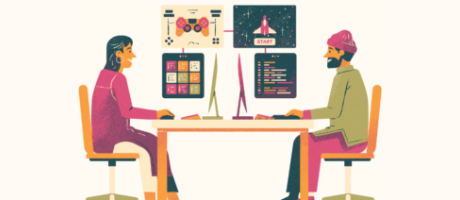How to Become a Bubble Freelancer
22nd of October, 2024
In this guide, you’ll learn how to become a paid Bubble Developer and master everything you need to know about setting up and operating your own no-code freelance business from scratch.
How to Become a Bubble Freelancer: Path to High-Paying No-Code Projects
Throughout this guide you’ll learn:
How to Become a Bubble Freelancer: Path to High-Paying No-Code Projects
2. Maximizing Opportunities as a Freelance Bubble Developer
3. Essential Skills for a Freelance Bubble Developer
1. Bubble Freelancing 101
The rise of no-code tools like Bubble has transformed the freelancing landscape, allowing developers to create web and mobile applications quickly and without traditional coding. In this guide, we’ll explore how you can leverage Bubble’s capabilities to become a successful and highly-paid freelancer.
Why Bubble Freelancing is Popular
Not long ago, building an app required manually writing code, a process that could take 12 to 18 months or longer. Developers and engineers, due to the complexity and exclusivity of coding, charged high fees for their work. Today, Bubble simplifies app creation by offering a visual programming interface, reducing development timelines to just 1 to 6 months, making it more cost-effective for businesses. Projects that used to cost upwards of $50,000 can now start at around $5,000, depending on the scope.
For businesses, working with a Bubble freelancer offers two key advantages:
- Lower costs: Reduced development time means lower expenses.
- Simplified handover: Because Bubble is a visual tool, it’s easier for clients to understand and manage the applications after the project ends, creating a better overall experience.
The Versatility of Bubble
One of the major reasons Bubble has gained so much traction is its versatility. It can be used to build applications for nearly every industry, covering a wide range of use cases. Whether it’s a startup founder needing a minimum viable product (MVP) or a small business owner requiring an internal tool, Bubble is equipped to handle it.
Here are three types of clients you can expect to work with as a Bubble freelancer:
- Startup Founders: Many startup founders need a quick, reliable way to build an MVP to test the market. Bubble is perfect for this, as it allows rapid iteration without the long development cycles of traditional coding. These clients are often well-versed in tech and understand the challenges freelancers face, making them ideal to work with.
- Small to Medium-Sized Business Owners: Business owners often need digital products to complement their existing services but may lack the time or expertise to build them from scratch. They frequently outsource the development to freelancers and prefer to retain control after the project is complete. To ensure long-term satisfaction, freelancers should provide thorough documentation that allows the business owner to manage and update the product independently.
- Businesses Needing Internal Tools: Many small businesses require custom-built internal tools to streamline operations. Similar to other business owners, these clients value control over their final product and often require documentation for future modifications.
Delivering Value to Clients
To succeed as a Bubble freelancer, you need to understand the value each client perceives. For example, if you’re building a customer-facing tool for a small business that costs $10,000, consider how much revenue it might generate for the business. If the tool is likely to bring in more than that amount, it’s an easy decision for the client to proceed with the project.
For clients needing internal tools, think about the time-saving aspect. If a tool can save hours of manual work, calculate how much that time is worth to the business. If the savings exceed the cost of the project, you can easily justify your fee.
Why Bubble is the Top Pick for Businesses
Bubble has been around for over a decade, which makes it a trusted and mature platform compared to newer no-code tools. Clients want solutions that will last, and working with a well-established tool like Bubble gives them confidence that their investment won’t become obsolete.
Additionally, Bubble’s extensive ecosystem of plugins and third-party API integrations allows freelancers to build a wide variety of applications, expanding the possibilities of what can be created.
If you’re looking to become a successful freelancer in the no-code space, Bubble offers you the tools to build high-quality apps efficiently. From startup MVPs to internal business tools, the opportunities are vast. By understanding your clients’ needs and the value you bring to their business, you can position yourself as a highly-paid Bubble freelancer.
2. Maximizing Opportunities as a Freelance Bubble Developer
As a freelance Bubble developer, there are key strategies you can implement to maximize your opportunities and grow your business. One of the most important aspects is becoming an experienced practitioner and communicating your skills effectively to the world. Demonstrating your expertise not only boosts your credibility but also creates opportunities for inbound leads. When clients see your skillset and feel a connection before even speaking with you, it builds trust, making it easier to attract projects.
Another crucial component is setting clear boundaries in terms of the projects you take on. As tempting as it may be to accept every opportunity, it’s essential to focus on projects that align with your long-term goals. Time is a finite resource, so by being selective, you ensure that you’re working on high-value projects that benefit you in the long run.
Positioning yourself as a forward-thinking freelancer is another powerful way to enhance your reputation. Staying ahead of trends in the Bubble ecosystem and showcasing your knowledge of the latest tools and features helps build social proof, trust, and confidence with clients. By consistently staying on the cutting edge, you’ll be able to close more projects and maintain a strong presence in the freelancing market.
If you’d like to get access to the full freelancing masterclass, you can purchase the complete course here:
3. Essential Skills for a Freelance Bubble Developer
To kickstart your freelancing journey as a Bubble developer, there are essential hard and soft skills you’ll need to master. While you don’t need to be the world’s best developer to begin, understanding the progression of skill levels from beginner to advanced is key to growing your freelance career. Here’s a breakdown of both technical and interpersonal skills that will guide you through the process.
Hard Skills: The Development Tiers
Bubble development can be categorized into three skill levels—beginner, intermediate, and advanced—each with its own set of requirements and project types.
1. Beginner Tier: At the beginner level, you’ll handle simpler projects.
Key skills include:
- Basic database setup and optimization.
- Using custom states and URL parameters.
- Ensuring full responsiveness for mobile and desktop devices.
These foundational projects are great for getting started and building your confidence without overpromising. Mastering these skills allows you to begin taking on client work while laying a solid foundation for more advanced tasks in the future.
2. Intermediate Tier: As you move to the intermediate level, you’ll work on more complex applications like marketplaces, social networks, and on-demand services.
Key skills include:
- Advanced database optimization for handling large user bases.
- Efficient searching and responsive data fetching.
- Implementing payment processing systems (e.g., using Stripe Connect).
- Utilizing advanced plugins and integrations, such as connecting with third-party email service providers via APIs.
These skills are vital for scaling projects and increasing your freelance rates as you gain experience.
3. Advanced Tier: At the advanced level, you’ll handle highly sophisticated applications, such as those with video-based features or complex workflows.
Key skills include:
- Setting up custom APIs and handling data from third-party services.
- Mastery of backend and scheduled workflows, including recursive workflows.
- Connecting to external databases (e.g., AWS or Google Firebase).
- Implementing custom CSS for further flexibility in Bubble’s design capabilities.
These skills will position you as a high-level developer capable of delivering premium services for complex projects.
Soft Skills: Building Client Relationships
While technical expertise is critical, soft skills can be the defining factor that sets you apart from other freelancers. As clients aren’t just buying technical solutions, they are investing in trust and communication. Key soft skills include:
1. Rapport Building
Before a client commits to a project, they need to feel a connection. Building rapport helps you identify their pain points and tailor your service to their specific needs.
2. Communication
Clear and consistent communication throughout the project helps prevent misunderstandings and surprises. This improves client satisfaction and ensures smoother project execution.
3. Project Ownership
Clients hire freelancers to take the burden off their shoulders. As a Bubble freelancer, you need to lead the project confidently, managing both the technical and operational aspects. The more ownership you take, the less micromanagement your client will feel the need to do.
4. Time Management
Freelancers often juggle multiple projects. The ability to prioritize tasks based on upcoming milestones ensures that projects are delivered on time, maintaining your reputation and workflow efficiency.
By mastering both hard and soft skills, you’ll position yourself as a well-rounded, in-demand Bubble freelancer who delivers high-quality results and excellent client experiences.
4. Building a Strong Portfolio
A well-constructed portfolio is non-negotiable for any freelancer, especially if you want to succeed as a Bubble developer. It’s your primary tool for demonstrating both your technical skills in Bubble development and your professionalism as a freelancer. Whether you’re just starting or looking to improve an existing portfolio, here’s how to optimize it for maximum impact.
Showcase Tangible Skills
The main purpose of a portfolio is to highlight your hard and soft skills. Potential clients need a way to see that you’re capable of delivering on their project requirements, and your portfolio is the perfect place to showcase this. It also builds social proof, helping clients trust that you’re good at what you do.
Even if you haven’t worked with paying clients yet, don’t let that hold you back. Building demo projects like a marketplace, directory, or social app on your own still demonstrates your capabilities in structuring databases, designing user interfaces, managing workflows, and integrating third-party services. These projects are highly relevant and can serve as valuable portfolio content.
Leverage Demo Projects
When you’re starting without client experience, it’s a good idea to create one to three demo applications. These demo projects should demonstrate your skills in a tangible way and reflect the kind of work you’d like to attract. Remember, clients will base their expectations on what they see in your portfolio, so make these projects as polished and professional as possible.
To give clients the best experience, ensure these applications are easily accessible and include visual aids like screenshots of your app. Make sure your app looks as appealing as possible. If you’re not a designer, no need to worry. There are plenty of resources like Dribble or Behance where you can find design inspiration, as well as UX/UI design resources available online.
Structuring Your Portfolio
When structuring your portfolio, start with the Hero Section. This section should include:
- A one-liner that succinctly summarizes what you do as a freelancer, tailored to your ideal clients.
- A clear call to action at the top of the page (e.g., a “Get in touch” button) to encourage immediate contact.
Next, outline the specific services you offer. Be as specific as possible about the types of projects you’re interested in. If you have past projects or demo projects to show, include them in a Portfolio Grid. For each project:
- Include a screenshot.
- Write a brief summary of what the app does.
- Provide a link to a detailed project page or case study.
Each project page should provide an in-depth look at the features you built and the overall project scope. Treat these project pages like case studies that walk potential clients through your process and highlight the skills you’ve used.
Build Trust with Personal Touches
After your portfolio grid, include an About Me section. This part is where you humanize yourself—talk about your journey, skills, and even fun facts. This helps build a relationship with potential clients before you ever speak to them. Be sure to include a professional headshot, as it adds a personal touch and helps clients put a face to the name.
Following that, add testimonials from past clients, if available, to reinforce your credibility and professionalism. These should include the client’s headshot, name, and job title. If you don’t have testimonials yet, focus on highlighting your demo projects and what makes you stand out as a freelancer.
Finally, end your portfolio with a contact form. Make it easy for clients to get in touch by asking for basic project details, including budget, and ensure that hitting “submit” triggers an immediate email to you, so you can respond quickly.
Get Creative
Your portfolio is not just about showing off your technical skills; it’s also a way to connect with potential clients. Whether through design, copy, or personal anecdotes, don’t be afraid to let your personality shine. The more relatable and approachable your portfolio feels, the easier it will be to build that essential trust with clients.
5. Mastering Cold Outreach as a Bubble Freelancer
One of the most crucial elements in establishing a successful freelance Bubble business is mastering the art of cold outreach. While your Bubble development skills are essential, it is equally important to excel in sales, especially cold outreach, which can be approached with a systematic, logical mindset—perfect for no-coders. Here, we’ll walk you through the essential steps to effectively execute cold outreach and land clients.
Cold Outreach: A Numbers Game
Think of cold outreach as a funnel where your input, or the number of emails sent, directly affects the output—potential opportunities. While it’s a numbers game, quality matters just as much as quantity. You need to ensure that the emails you send are meaningful and well-targeted to increase your chances of success.
Crafting the Perfect Cold Email
While the term “cold” may imply distance, your goal is to create a warm, personable introduction. The key to a successful cold email lies in research, personalization, and addressing the client’s needs. Here are the steps:
- Research, Research, Research
Before you send an email, thoroughly research your potential client. Understand their goals, challenges, and objectives. Your email should reflect that you’ve done your homework and are genuinely interested in helping them achieve their desired outcome. - Identify Pain Points and Solutions
Focus on how you can alleviate the client’s pain points. Identify the roadblocks they face in reaching their goals and explain how your Bubble expertise can remove those obstacles. This approach will make your email much more relevant and appealing. - Understand Where They Are in Their Journey
Tailor your pitch to where the client is in their business journey. Whether they’re just starting or looking to scale, align your services with their current needs and future objectives. - Know the Decision-Makers
Make sure you know who within the company makes the final decision. Your contact might not be the one who signs off on freelance projects, so understanding the organizational hierarchy can help craft a message that resonates not only with your contact but also with higher-ups.
Download the Sales Follow-Up Template and Tracker for Free:
Writing the Email
When it comes to actually writing the email, 80% of your time should be spent on research, with only 20% spent on writing. Here’s how to structure it:
- Be Direct and Human
Avoid unnecessary formalities like “I hope this email finds you well” or overly stiff language. Cold emails work best when they’re conversational and get straight to the point. - Eliminate Small Talk
Don’t waste time on pleasantries. The focus should be on the value you can add to their business, not on unnecessary chit-chat. - Make It About Them
Your cold email should focus almost entirely on the potential client, not on you. By the time they finish reading, they should feel that you understand their needs and are capable of delivering real value.
Show Credibility
Credibility builds trust. Include examples of your previous work to back up your claims. As a Bubble freelancer, providing tangible proof of successful projects can help you stand out from the competition.
The Call to Action (CTA)
Every cold email needs a clear and concise call to action. Be sure to keep it simple—too many options can overwhelm the reader and result in inaction. Stick to one CTA, such as scheduling a call or requesting further information.
Follow the AIDA Framework
AIDA is a proven copywriting framework that works well for cold emails:
- Attention: Start with a hook to grab the client’s attention.
- Interest: Maintain interest by addressing their problem or challenge.
- Decision: Introduce your solution to help them make a decision.
- Action: End with a clear CTA to move the process forward.
By following these steps and leveraging the AIDA framework, you can create cold outreach emails that are highly targeted, persuasive, and more likely to convert into freelance projects.

Mastering cold outreach takes practice, but once you refine your approach, it will become an invaluable tool in growing your freelance Bubble business.
If you’d like to get access to the full freelancing masterclass, you can purchase the complete course here:
Also, checkout our the Cold Email Outreach Template completely for free.







